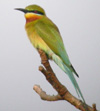INTRODUCTION
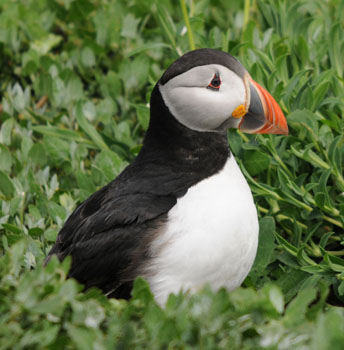 We decided to spend a few days in the north east, based west of Newcastle, to add a few species to our year list, with our targets being terns in the main.
We decided to spend a few days in the north east, based west of Newcastle, to add a few species to our year list, with our targets being terns in the main.
DIARY and SITE INFORMATION
Day 1 - Sunday 23rd May
On the way we called at Stanhope in Co Durham to visit our son and after lunch went to nearby Rookhope Burn, hoping to catch up with Spotted Flycatcher. Shortly after parking the car and walking into the riverside woodland we were enjoying good views of a pair carrying nesting material to a suitable hole in a nearby Ash. As we were moving on, we didn’t spend too long at this delightful little spot, but we did manage to catch a fleeting glimpse of a Dipper heading upstream. Having checked in to our hotel for the next three nights, we drove north to Amble to check tide and sailing times for the next few days as we planned to visit both the Farnes and Coquet Island. We decided to pop back to an Italian Restaurant (Gianni’s Pizzeria 01670 511547) in Morpeth for a bite to eat and, much to our surprise, picked up our first Grey Wagtail of the year on a town centre roof-top (the River Wansbeck runs almost through the middle of the town here, so we shouldn’t have been that surprised really, but we hadn’t seen any previously in much more favourable habitat). After dinner we went to Hauxley to check out the nesting Barn Owl at the nature reserve. As dusk approached all was quiet however, with no sign of the owls. We saw quite a few species on our travels today, but nothing really out of the ordinary; there was a scattering of Red Grouse, Wheatear and nesting waders on the moors on our way over to the east coast.
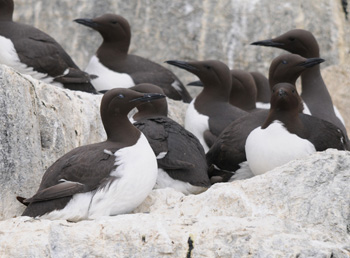 Day 2 - Monday 24th May
Day 2 - Monday 24th May
Our first stop today was at Newton Pools, on our way to Seahouses for a lunch-time boat trip around the Farne Islands. The air was rife with birdsong, with Reed Bunting, Sedge Warbler, Willow Warbler and Whitethroat proving the most vocal. With noon approaching we moved on further north to catch the 13.00hrs boat to Inner Farne with Billy Shiel, having pre booked (01665 720308) about a week earlier. On arrival at the quayside we were advised “one of the boats was not available” and we would therefore have to travel with another company who were a little further along the quay. The sea was relatively calm as we cruised around all the islands before landing for an hour on Inner Farne. At a cost of £13 each, plus £4 for parking and £6 each to The National Trust to land on Inner Farne, the cost of £42 for a couple is not cheap, but if you want to do some close-up photography of auks and seabirds and don’t mind getting dive-bombed (and occasionally crapped upon) by the nesting Arctic Terns, then this is the experience for you! 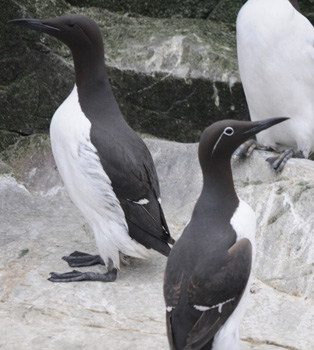 There are Puffin and Guillemot (including a few bridled Guillemot) in their thousands with a much smaller number of Razorbill and Shag. Cormorant, Fulmar and Kittiwake also nest on the islands along with Eider, an array of gulls, Sandwich Tern and by far the most numerous, Arctic Tern. Common Tern occasionally put in an appearance whilst Ringed Plover can be found dotted around the shoreline.As we were sailing around Longstone in search of seals, the majestic Gannet were briefly joined by a flock of c12 Manx Shearwater. After our 2½ hour trip around the Farnes we set off south again for The Long Nanny to visit the nesting tern colony, made up mainly of Arctic Tern, but with a good number of the delightful Little Tern alongside nesting Ringed Plover. Walking north across the bridge (where confiding Swallow often perched) towards the caravan site at Beadnell, there is a flooded field on the west of the coastal track, looking quite permanent and ideal for waders and ducks. There had been reported sightings of 2 Temminck’s Stint on the pool for a few days previously: unfortunately we could find no sign of the birds, but we did see 2 Greenshank, a Dunlin and a Ruff, whilst Meadow Pipit were everywhere. After a long day in the field we retreated to our usual watering hole when in the vicinity, The Mason’s Arms at Rennington (01665 577275) for a well earned dinner.
There are Puffin and Guillemot (including a few bridled Guillemot) in their thousands with a much smaller number of Razorbill and Shag. Cormorant, Fulmar and Kittiwake also nest on the islands along with Eider, an array of gulls, Sandwich Tern and by far the most numerous, Arctic Tern. Common Tern occasionally put in an appearance whilst Ringed Plover can be found dotted around the shoreline.As we were sailing around Longstone in search of seals, the majestic Gannet were briefly joined by a flock of c12 Manx Shearwater. After our 2½ hour trip around the Farnes we set off south again for The Long Nanny to visit the nesting tern colony, made up mainly of Arctic Tern, but with a good number of the delightful Little Tern alongside nesting Ringed Plover. Walking north across the bridge (where confiding Swallow often perched) towards the caravan site at Beadnell, there is a flooded field on the west of the coastal track, looking quite permanent and ideal for waders and ducks. There had been reported sightings of 2 Temminck’s Stint on the pool for a few days previously: unfortunately we could find no sign of the birds, but we did see 2 Greenshank, a Dunlin and a Ruff, whilst Meadow Pipit were everywhere. After a long day in the field we retreated to our usual watering hole when in the vicinity, The Mason’s Arms at Rennington (01665 577275) for a well earned dinner.
Day 3 - Tuesday 25th May
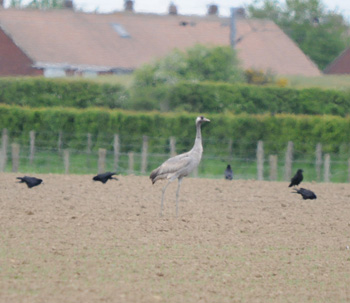 The previous day we had heard reports of a single Common Crane around Widdrington Station and in the evening had returned to our hotel via this area without any success. Today we decided to start North of Linton Colliery on the road to Ulgham in search of the bird and within 2 minutes of our first stop we located the Common Crane in ploughed fields near a large electricity sub-station, with the whole area backing on to Widdrington Station. After watching the bird for about 20 minutes it flew off in the direction of Cresswell Ponds, so we decided to head after it, as we had a couple of hours to kill before our noon sailing from Amble to Coquet Island with Omega Charters (booking recommended 01665 710835). There was no further sign of the Crane at Cresswell. However, we did find an immature Little Gull preening and resting on a mud bank alongside a few other gulls. There were also Tree Sparrow and Linnet on the track past the farm, leading to the hide. A strong north easterly breeze had picked up overnight and the trip to Coquet Island was therefore a little more eventful than the previous day’s to the Farnes. Omega use a 12 seater, stable, high powered catamaran, are licensed by the RSPB to service the reserve and have a couple of moorings near the island, from which good views of the nesting Roseate Tern can be obtained. The strong wind and the rising tide prevented us from using the mooring nearest the island and made photography quite difficult, but we were still able to get good views of the terns, along with several Purple Sandpiper and Turnstone on the rocky foreshore. Arctic Tern and Puffin are by far the commonest birds nesting here.
The previous day we had heard reports of a single Common Crane around Widdrington Station and in the evening had returned to our hotel via this area without any success. Today we decided to start North of Linton Colliery on the road to Ulgham in search of the bird and within 2 minutes of our first stop we located the Common Crane in ploughed fields near a large electricity sub-station, with the whole area backing on to Widdrington Station. After watching the bird for about 20 minutes it flew off in the direction of Cresswell Ponds, so we decided to head after it, as we had a couple of hours to kill before our noon sailing from Amble to Coquet Island with Omega Charters (booking recommended 01665 710835). There was no further sign of the Crane at Cresswell. However, we did find an immature Little Gull preening and resting on a mud bank alongside a few other gulls. There were also Tree Sparrow and Linnet on the track past the farm, leading to the hide. A strong north easterly breeze had picked up overnight and the trip to Coquet Island was therefore a little more eventful than the previous day’s to the Farnes. Omega use a 12 seater, stable, high powered catamaran, are licensed by the RSPB to service the reserve and have a couple of moorings near the island, from which good views of the nesting Roseate Tern can be obtained. The strong wind and the rising tide prevented us from using the mooring nearest the island and made photography quite difficult, but we were still able to get good views of the terns, along with several Purple Sandpiper and Turnstone on the rocky foreshore. Arctic Tern and Puffin are by far the commonest birds nesting here. 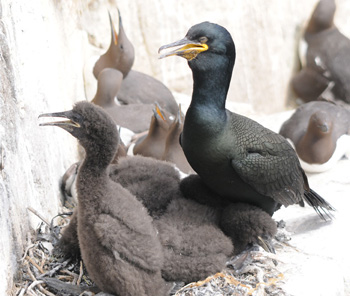 The cost for this trip was a more reasonable £6 per head, but it was only afterwards (at home!) when we read the promotional literature we realised there was a £0.50 discount for RSPB members; pity the sales team didn’t point it out to us. Following our trip we returned briefly again to The Long Nanny in search of Temminck’s Stint after yesterday’s failure. This time we were successful, eventually finding two small waders amongst the Greenshank and Shelduck chicks. With the sun in our eyes and a heat haze across the water it was impossible to produce a definitive identification, other than to say there had been two birds there for a few days before and at least one day after our visit and based on size alone these two birds were definitely stints; but as to which one - we had to trust others who had had better views. From here we moved on to East Chevington where we saw a good selection of ducks and gulls, but nothing particularly out of the ordinary other than single Ruff and Black-tailed Godwit and a lingering pair of Wigeon. Sedge Warbler, Whitethroat, Reed Bunting and Stonechat were all pretty active around the reserve. After another long day we retreated the The Mason’s Arms again.
The cost for this trip was a more reasonable £6 per head, but it was only afterwards (at home!) when we read the promotional literature we realised there was a £0.50 discount for RSPB members; pity the sales team didn’t point it out to us. Following our trip we returned briefly again to The Long Nanny in search of Temminck’s Stint after yesterday’s failure. This time we were successful, eventually finding two small waders amongst the Greenshank and Shelduck chicks. With the sun in our eyes and a heat haze across the water it was impossible to produce a definitive identification, other than to say there had been two birds there for a few days before and at least one day after our visit and based on size alone these two birds were definitely stints; but as to which one - we had to trust others who had had better views. From here we moved on to East Chevington where we saw a good selection of ducks and gulls, but nothing particularly out of the ordinary other than single Ruff and Black-tailed Godwit and a lingering pair of Wigeon. Sedge Warbler, Whitethroat, Reed Bunting and Stonechat were all pretty active around the reserve. After another long day we retreated the The Mason’s Arms again.
Day 4 - Wednesday 26th May
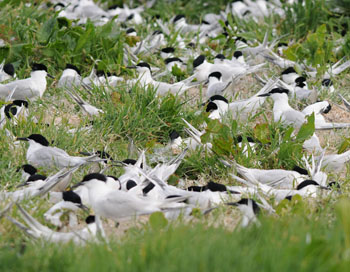 Heading south on our way home again we decided to make a detour off the A1 and head over to RSPB Saltholme reserve near Middlesbrough for lunch and a final spot of birdwatching. The Temminck’s Stint which had been here for a few days was playing hide and seek around the distant water meadows at the Port Clarence side of the reserve and a lone Turtle Dove had been spotted early in the morning. Both went on the too difficult pile and with Meadow Pipit once again seemingly everywhere, we settled for several beautiful Yellow Wagtail and a nice juvenile Little Gull which we had to point out to one of the wardens who was in the hide, busy telling all who would listen about his life so far! With everything quiet on the western front we made an early start for home.
Heading south on our way home again we decided to make a detour off the A1 and head over to RSPB Saltholme reserve near Middlesbrough for lunch and a final spot of birdwatching. The Temminck’s Stint which had been here for a few days was playing hide and seek around the distant water meadows at the Port Clarence side of the reserve and a lone Turtle Dove had been spotted early in the morning. Both went on the too difficult pile and with Meadow Pipit once again seemingly everywhere, we settled for several beautiful Yellow Wagtail and a nice juvenile Little Gull which we had to point out to one of the wardens who was in the hide, busy telling all who would listen about his life so far! With everything quiet on the western front we made an early start for home.
SUMMARY
Although there had been a cold wind blowing after a beautiful, hot and sunny first day, we managed to steer clear of rain, catch up with all our target species and a few more besides and enjoy a short break from the late spring gardening chores back home. Total species for the trip: 91.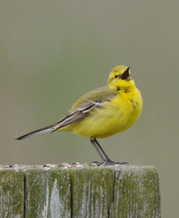
Species List
Map of The Farne Islands
David and Amanda Mason
